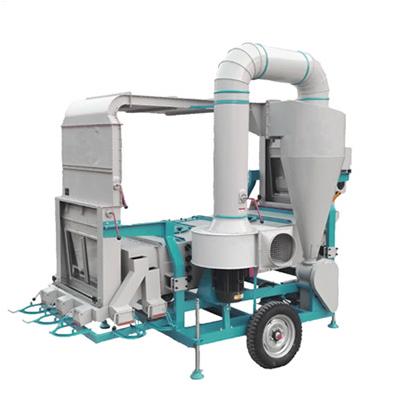Efficient grain processing equipment is one of the key factors to ensure grain quality. With the advancement of science and technology, medium and large grain cleaning and screening machine production lines have occupied an important position in the market due to their high efficiency, stability and high degree of automation.
Configuration recommendation
For medium and large grain cleaning production lines and screening production lines, the core configuration includes but is not limited to: feeding device, cleaning and screening unit, conveying system, dust removal device and control system. The feeding device is responsible for evenly feeding the raw grain into the production line; the cleaning and screening unit removes impurities through multi-stage screening to improve the purity of grain; the conveying system ensures the smooth flow of materials between various links; the dust removal device is used to collect dust generated during the processing process to reduce environmental pollution; and the advanced control system can achieve precise control and optimization of the production process and improve overall efficiency. According to different types of grains (such as wheat, corn, rice, etc.), it is also necessary to select matching specific functional modules, such as shellers for wheat and peelers for corn.
How do ordinary people choose the production capacity?
Choosing the appropriate production capacity requires comprehensive consideration of factors such as actual needs, budget constraints and site conditions. First, clarify the amount of grain expected to be processed daily or monthly, and use this as a basis to determine the basic production capacity of the production line. Secondly, considering the increase in demand that may be caused by seasonal fluctuations or market changes, it is recommended to reserve a certain amount of margin. In addition, it is necessary to evaluate the existing warehouse capacity and the possibility of future expansion. Finally, estimate the balance between investment cost and operating cost, and reasonably select cost-effective equipment models. For example, if it is a small processing plant, a daily processing capacity of 50-200 tons can meet daily needs; for large enterprises, a production line with a daily processing capacity of more than 500 tons or even higher may be required.
Preliminary preparation
Before installation and use, sufficient preparations must be made. First, conduct a field survey of the proposed site to ensure that all physical conditions for equipment installation are met, such as ground flatness, space height, etc. Second, according to the guidance in the equipment manual, plan in advance the layout of related supporting facilities such as power supply and water source access. Third, form a team of experienced technicians who can not only operate these complex equipment proficiently, but also solve possible technical problems in a timely manner. Finally, organize relevant personnel to participate in professional training courses to familiarize themselves with the operating procedures and maintenance knowledge of the entire production line, so as to ensure the long-term and stable operation of the equipment.
Industry prospects and profits
With the global population growth and changes in dietary structure, the demand for high-quality food is increasing, which has brought unprecedented development opportunities to the food processing machinery industry. In particular, the improvement of environmental awareness in recent years has prompted more and more companies to adopt cleaner and more efficient production methods, further promoting the development of this field. From the perspective of profit, despite the large initial investment, with its high efficiency and low energy consumption, medium and large-scale grain cleaning and screening machine production lines can significantly reduce the processing cost per unit product and improve market competitiveness. At the same time, due to its long service life and relatively low maintenance cost, it can bring considerable economic benefits to enterprises in the long run.
In short, medium and large-scale grain cleaning and screening machine production lines have become an indispensable part of modern grain processing with their excellent performance. Through scientific and reasonable purchase and management, it can not only effectively improve the quality of grain processing, but also help enterprises seize industry development opportunities and achieve sustainable development.
Post time: Jan-02-2025


